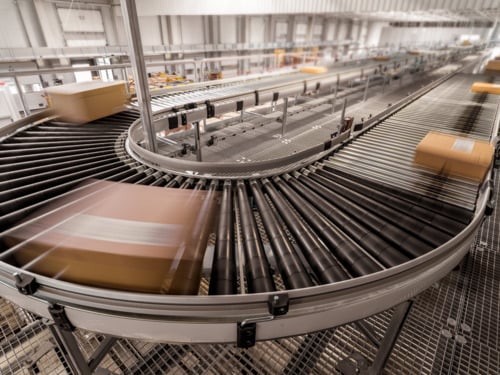Automate freezer storage and handling with TGW equipment engineered to sub-zero standards
As the first automated logistics solution provider to offer an automated freezer handling system based on standardized products and components, TGW Logistics Group meets the challenges faced by cold and freezer chain warehouses and distribution centers while delivering the lowest total cost of ownership. Every TGW system, component and product can be used in temperatures from 104 to -22 degrees Fahrenheit (+40 to -30 degrees Celsius).
Frozen pizza, vegetables or ice cream — before a consumer brings frozen food home it travels through an unbroken cold chain. “Ensuring the highest possible quality is crucial when it comes to food," says Michael Schedlbauer, Industry Manager for grocery retail at TGW. “We understand that high-performance freezer material handling technology contributes to meeting high quality standards. For us, freezer logistics is the standard to which all of our logistics solutions are designed and engineered.”
Standardized TGW freezer solution increases productivity, lowers total cost of ownership
Because TGW experts have been automating freezer warehouses end-to-end — from in-bound receiving to out-bound shipping and all points in between — for years, they leveraged that knowledge into the development of the Stingray Shuttle storage and retrieval technology.
The all-wheel-drive Stingray Shuttle can be installed and operated in temperatures from 104 to -22 degrees Fahrenheit (+40 to -30 degrees Celsius). “For sub-zero environments, we modify the Stingray with two components manufactured from materials that more readily adapt to the freezer conditions — similar to winterizing a car,” Schedlbauer notes. “The performance of the freezer technology is equal to that of equipment operating in normal temperatures.”
Automation of freezer and cold storage warehouses within the retail grocery industry — from depalletizing to storage to picking to transport to palletizing — offers a variety of benefits, including increased worker productivity. Fully automated solutions improve worker comfort and ergonomics in physically demanding freezer environments, allowing them to pick more products in less time.
Further, for ease of maintenance and repairs, the Stingray Shuttles can be removed from their aisles via a special lift, then serviced in an area with more ambient temperatures for faster and more reliable work.
Additionally, the compact construction of the shuttle storage and retrieval system supports high storage density. That enables more products to be stored within a smaller facility footprint and greater energy efficiency — a key contributor to lowering total cost of ownership, adds Schedlbauer.
“Especially in sub-zero temperatures, it is crucial to consider the operating costs and the energy efficiency of an automated solution. Because a shuttle warehouse needs less space and delivers a higher storage density, it yields significantly less area that has to be cooled. That translates into significantly lower energy costs,” he explains.
Coop’s fully automatic, energy efficient freezer warehouse
"TGW was the first company to bring a standardised shuttle system for freezer warehouses onto the market. Our largest shuttle-based freezer solution to date, for Swiss retail grocer Coop, went live a short time ago," Schedlbauer continues.
At the Coop site in Schafisheim, Switzerland, TGW implemented an extensive logistics system comprising not only a fully automatic freezer warehouse but also a warehouse for dry goods, a cooler area and an empty totes center. Temperatures range from -13 degrees Fahrenheit (-25 degrees Celsius) in the freezer, to ambient conditions for dry goods.
Within the Coop facility, frozen products are stored in a pallet warehouse with 17,000 storage locations, maintained at -13 degrees Fahrenheit (-25 degrees Celsius). TGW Splitex depalletizing machines split the pallet loads into separate cases, which are then stored by the Stingray Shuttles in 40,000 storage locations at rates of up to 4,500 cartons per hour. When called for by orders, the shuttles retrieve the required products and deliver them to conveyors that then transport them to fully automated TGW Autostax palletising stations. There, volume-optimised and store-friendly pallet loads are built according to pre-defined packing patterns.
By switching over to a fully automated system, not only does Coop maintain the highest quality frozen food chain handling system at the lowest total operating cost, but the company has also minimized its ecological footprint, adds Schedlbauer. "Coop’s Schafisheim logistics center has reduced its carbon dioxide emissions by 10,000 tons per year by implementing TGW technology.”
More information on TGW's freezer technologies can be found here.

